Learn how to make einkorn sourdough bread with this simple, no-knead recipe.
Only four ingredients - all-purpose einkorn flour, salt, water and a sourdough starter are all you need for healthy, naturally-leavened bread.
With this recipe you can mix the dough and bake the bread on the same day!
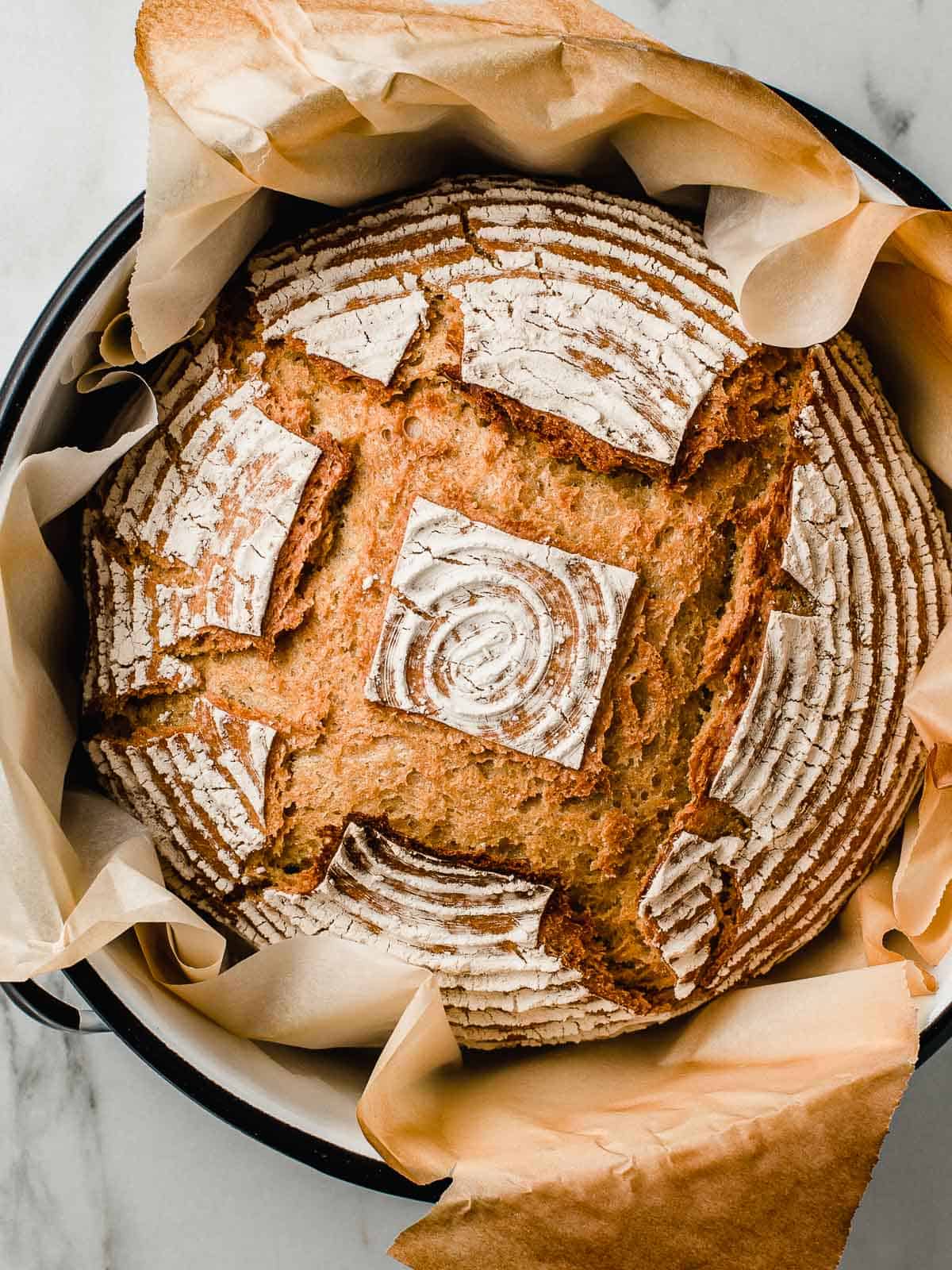
If you've never baked with einkorn flour, you are in for a real treat. This fail-proof recipe for einkorn sourdough bread will have you jumping for joy in your kitchen!
Follow the steps in this recipe and you'll get a light loaf with plenty of oven-spring.
It produces a nice, even crumb that is perfect for making sandwiches, french toast or dipping in your favorite soup!
Einkorn wheat has become our favorite way to enjoy sourdough!
Jump to:
What is einkorn?
Einkorn is the oldest form of wheat and is often referred to as an ancient grain. It is the only wheat that has never been hybridized.
Einkorn is organically grown and free from glyphosate and bleach.
Because it lacks the y-gliadins gluten protein group, which are present in all other types of wheat, einkorn flour is easier to digest then modern wheat varieties.
Einkorn also beats out modern wheat by containing more nutrients such as carotenoids, B vitamins, and essential and trace minerals.
The result is a bread that is rich in flavor, color and nutrition.
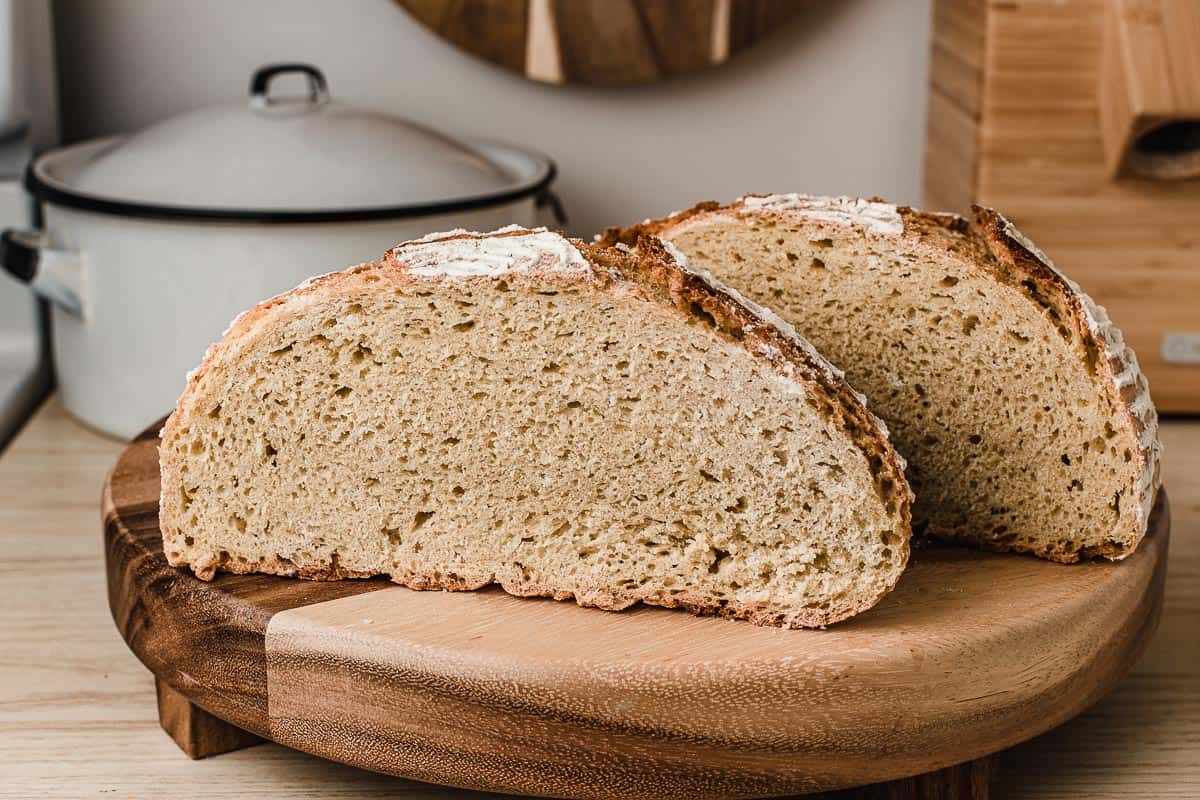
What you'll need
Just like our other sourdough bread recipes, the ingredients are simple.
- sourdough starter
- all-purpose einkorn flour (affiliate link)
- salt
- water
Equipment needed
(Amazon affiliate links) - Check out my favorite kitchen essentials.
Step by step instructions
When einkorn flour is mixed with water it is much more sticky than modern wheat. Don't be afraid to add flour as needed when folding and shaping the dough.
A bench scraper will be your most useful tool while making this bread. Be sure to have one handy!
Step one: feed the sourdough starter
The night before you wish to mix your dough, prepare your sourdough starter. Because we want a slow, overnight rise on the starter, we use a ratio of 1 part starter to 4 parts flour and water.
To a clean jar add 25g sourdough starter, 100g water and 100g all-purpose einkorn flour. Stir, lightly cover and let rise at room temperature overnight.
NOTE: If you already have a sourdough starter made with a different variety of wheat, it can be used to make this recipe.
Step two: mix the dough
To a large mixing bowl add 200g of the active sourdough starter, 300g of water, 10g of sea salt and 540g of all-purpose einkorn flour.
Use a stiff spatula or a dough whisk to mix the ingredients together.
The dough will appear dry and "shaggy".
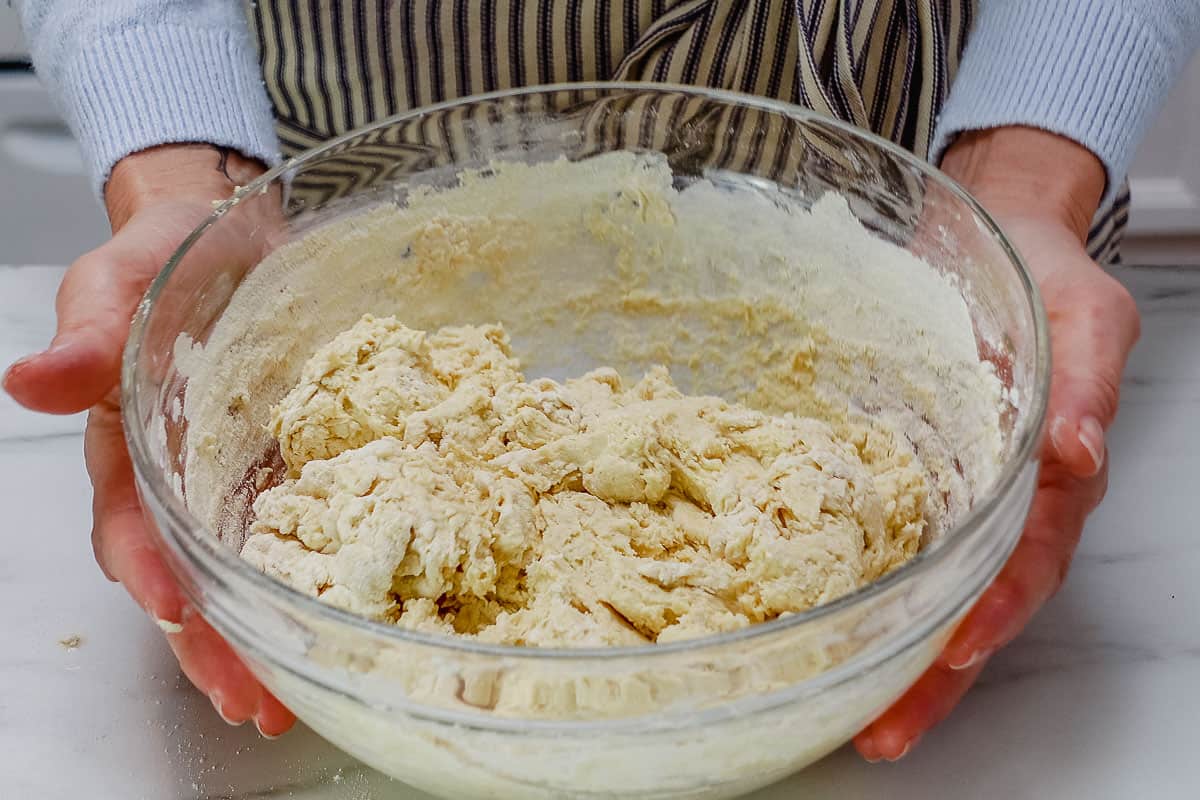
Cover the bowl and let the dough rest for 1 hour on the counter.
Step three: fold the dough
Use a bowl scraper to turn the dough out onto a floured work surface.
Flour the top of the dough and use your fingers to gently press it out into a rectangular shape.
Starting with one side of the dough, lift it up and fold it toward the center of the dough.

If the dough is sticking to the work surface, use the bench scraper to help it release.
Repeat this on all four sides of the dough and place the dough back into the bowl.
Cover the bowl and let the dough rest for 15 minutes.
Repeat the folding process one more time.
Step four: bulk rise
Cover the dough and let it rest at room temperature for 3-4 hours, or until it has risen by about 20-30%.
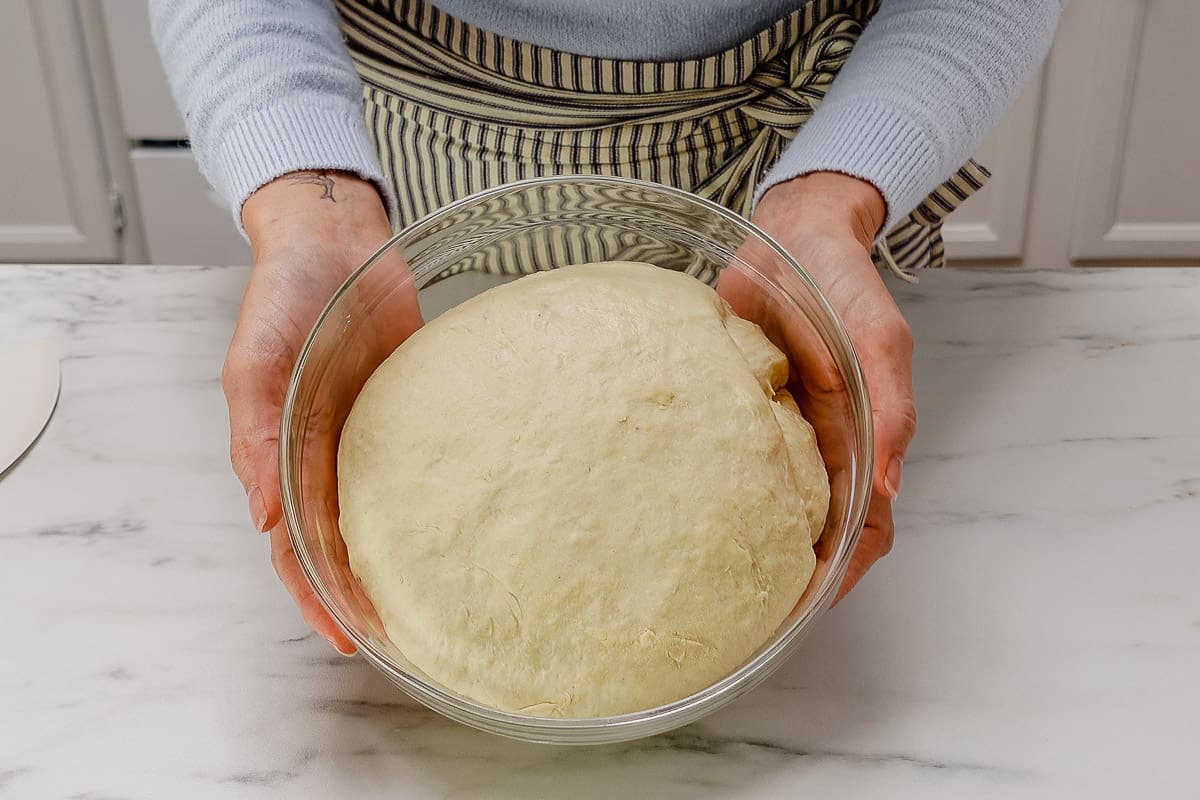
Step five: shape the dough
Generously flour a banneton or line it with a clean tea towel.
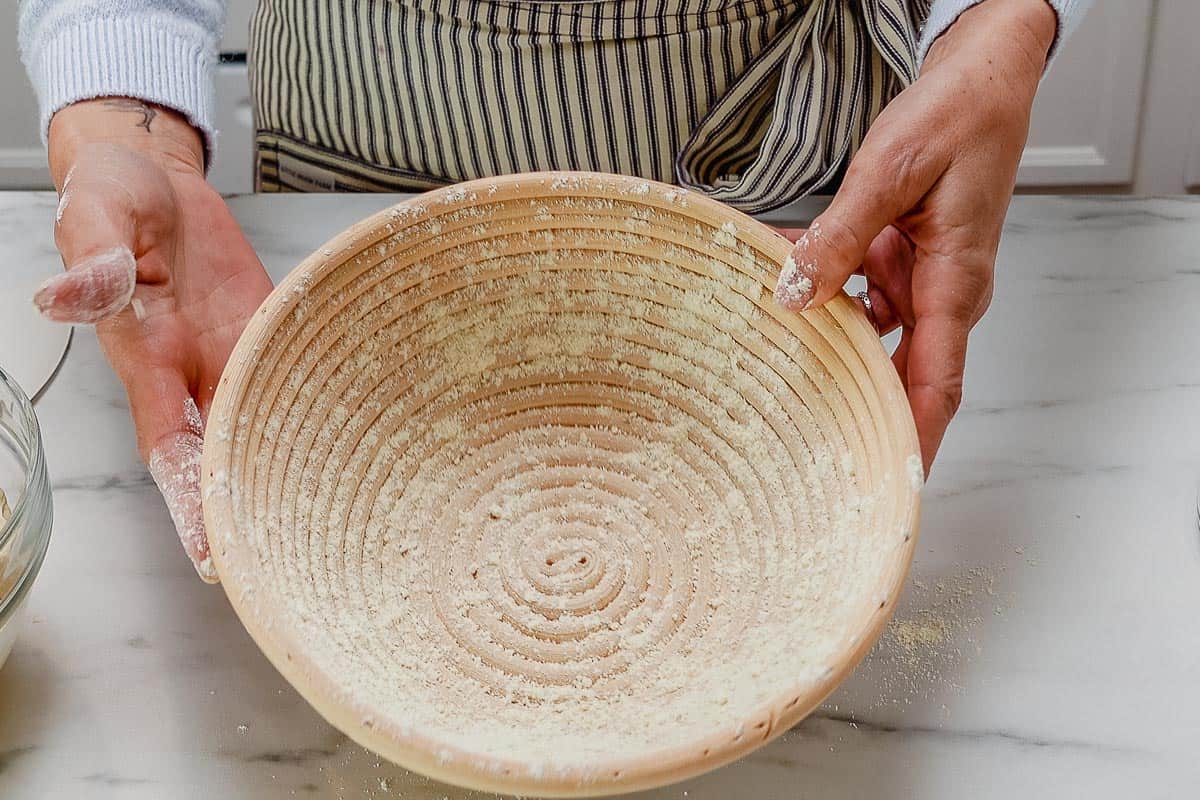
Turn the dough out onto a floured surface, but this time do not flour the top of the dough.
Pull the sides of the dough into the center.

Use the bench scraper to lift and flip the dough so that the seam-side is facing down.
Use your hands to cup the dough while gently turning it in a circular motion on the work surface.
If your hands start to stick to the dough you may lightly flour them but try not to use too much.
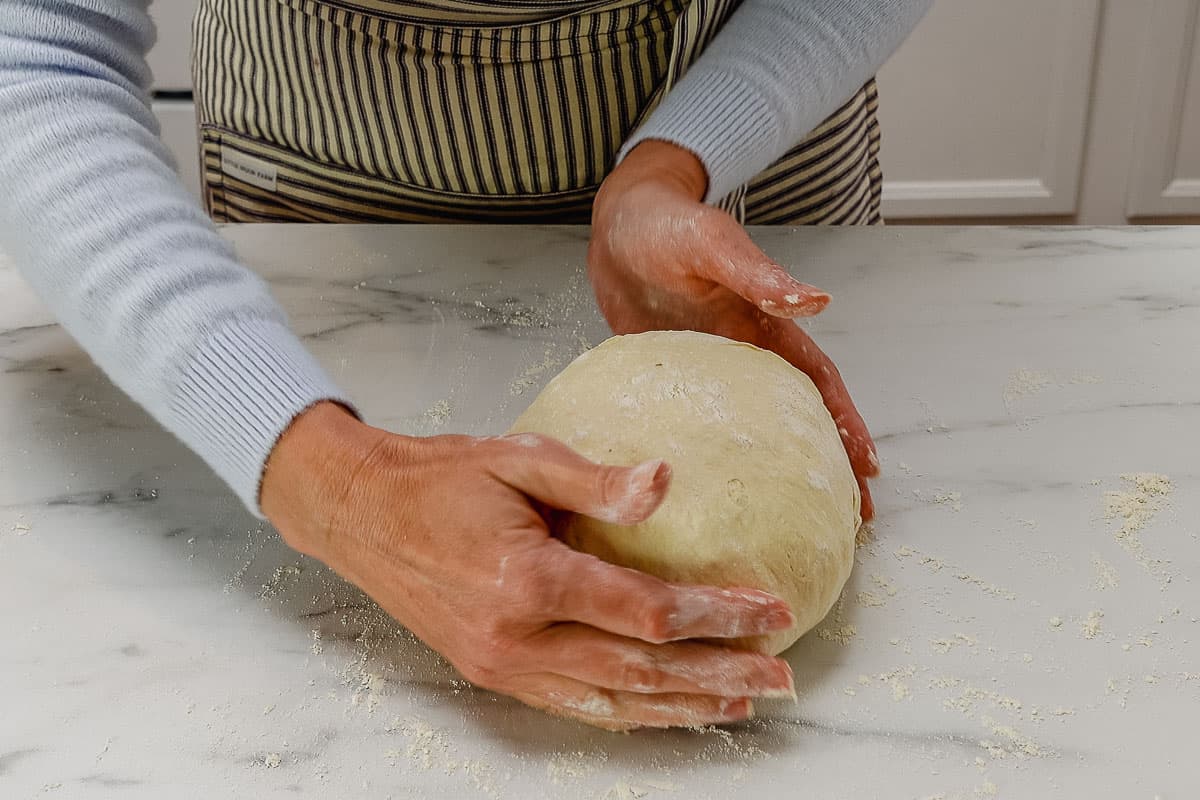
Use the bench scraper to pick up the dough and turn it over, into the banneton, with the seam-side facing up.

Cover the bowl and set a timer for 30 minutes. (This is when you'll preheat your oven.)
Allow the dough to rest at room temperature during the second rise.
Step six: second rise and preheat oven
The second rise will take about 90 minutes from start to finish, with the oven preheating in the final hour.
After the dough has rested for 30 minutes in the banneton, place your dutch oven into the oven on the second to lowest rack.
Allow the oven to preheat at 500°F(260°C) for 1 hour.
NOTE: The dough will have risen about 1 to 2 inches in the banneton when it is ready to bake.
Step seven: bake
Turn the dough out onto a piece of parchment paper and use a lame or sharp razor to score the top of the dough.
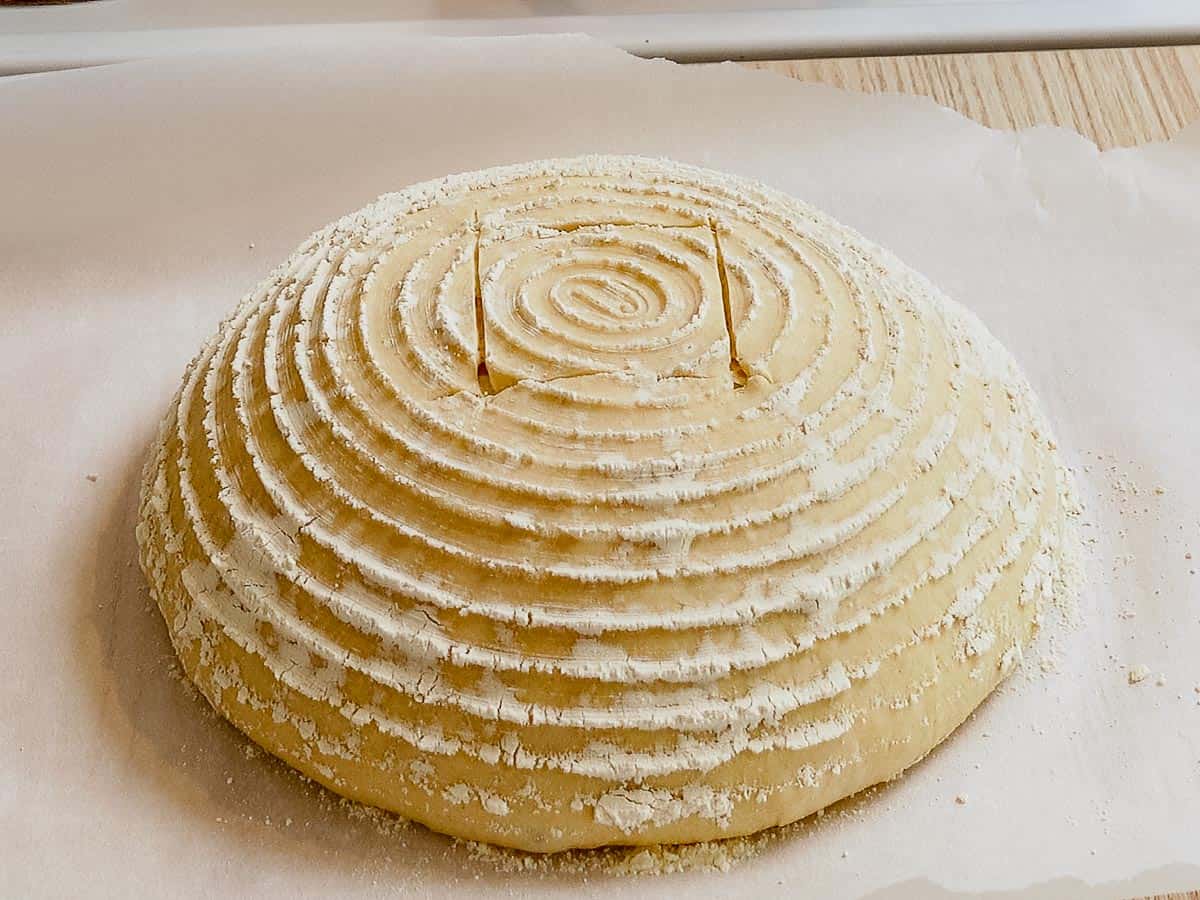
TIP: Because of the weak gluten structure of einkorn, it's important to make a shallow cut to the top of the dough, never on the sides. Do not score deeper than ¼" into the dough.
Use the parchment paper as a sling to pick the dough up and transfer it to the dutch oven. Place the lid on the pot.
Turn the oven temperature down to 450°F (232°C).
Bake the bread for 40 minutes.
After the 40 minutes is up, remove the lid and check to see if the crust is dark enough for your preference.
The bread can be baked uncovered for 5-10 more minutes in order to achieve a darker crust.
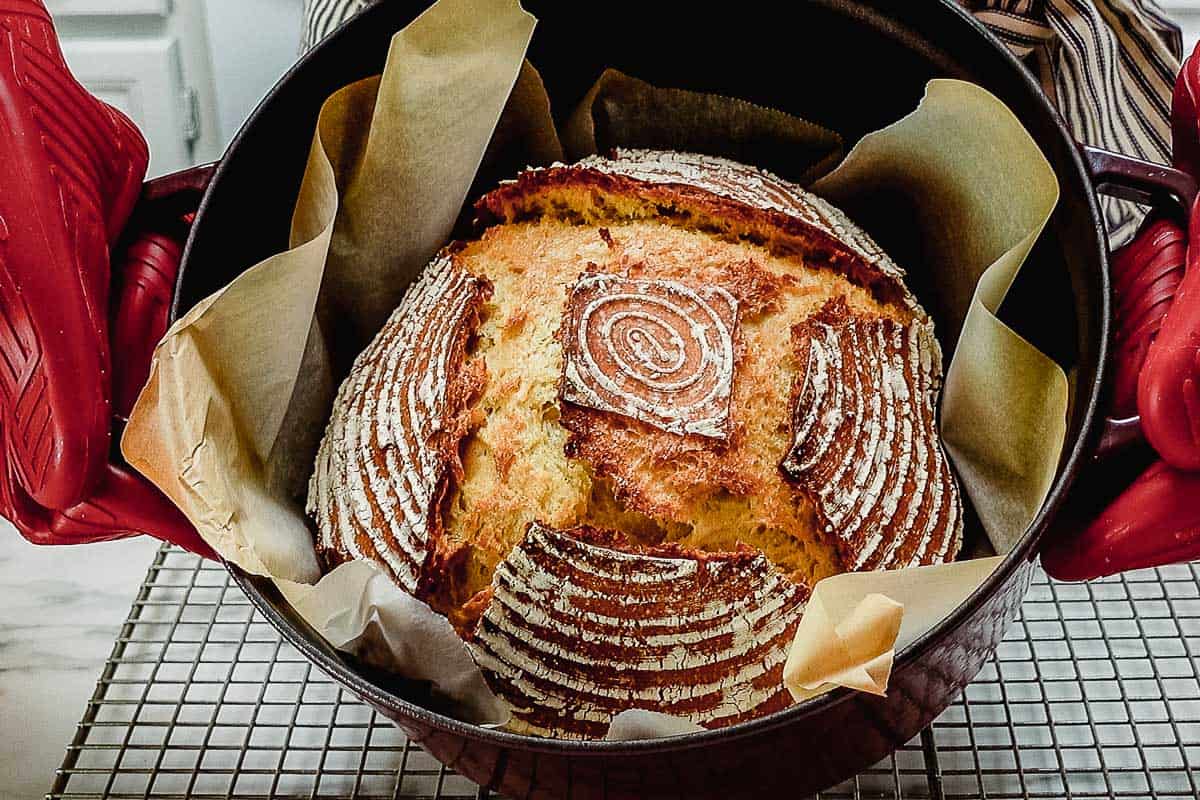
Step eight: cool
Transfer the loaf to a cooling rack and allow it to rest for 2 hours before slicing.
If you slice the bread while it is still hot, the texture of the crumb will be "gummy or sticky" from the heat and moisture.
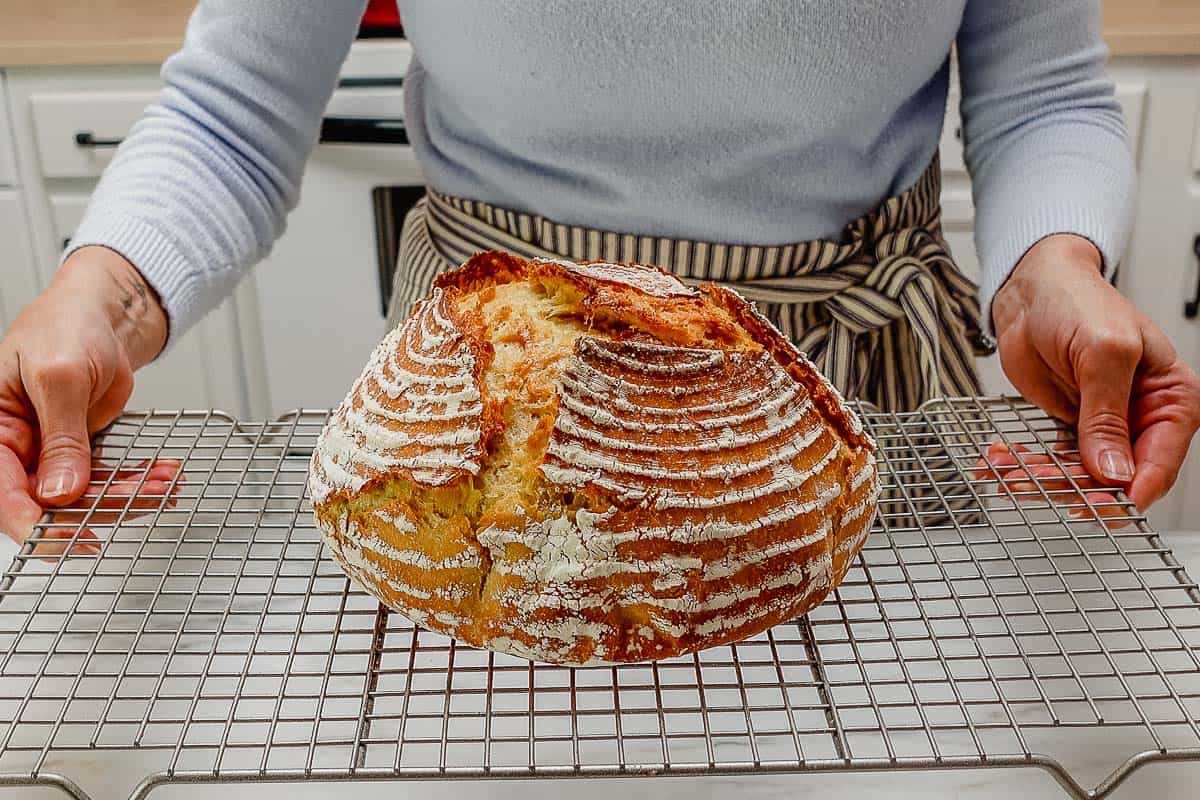
Sample baking schedule
The night before
7 PM Feed your sourdough starter so that it is bubbly and active in the morning.
The next morning
7 AM Mix the dough ingredients and let rest for one hour.
8 AM Fold the dough, cover and let rest 15 minutes.
8:15 AM Fold the dough, cover and let rest 3 hours.
11:30 AM Shape the dough and place in a floured banneton. Set a timer for 30 minutes to preheat the oven.
12 PM Place dutch oven into the oven and preheat it to 500°F (260°C) for 1 hour.
1 PM Turn the dough onto a piece of parchment paper and score the top. Transfer to the dutch oven, cover and bake for 40 minutes. Let cool for 2 hours.
NOTE: This is the schedule I use to bake einkorn sourdough bread. The temperature of my kitchen is 68°F (20°C). Warmer kitchens will require less time and cooler kitchens will require more time. Adjust your schedule accordingly.
How to store it
Store the bread at room temperature for up to 2 days either wrapped in a beeswax wrap, in a bread box, a bread bag or cut-side down on a cutting board covered with a cake-stand cover.
For long-term storage, cut the bread into slices and keep them frozen in a freezer-safe container for up to 1 month.
We love to use stasher-bags (affiliate link) for freezing sourdough bread slices.

Common questions
Einkorn is a wheat flour making it good for sourdough bread baking. A sourdough starter can be created and maintained using einkorn flour.
There are two ways to make a sourdough starter with einkorn. You can start from scratch with our sourdough starter recipe using einkorn flour OR you can convert the sourdough starter that you already have.
To convert your existing sourdough starter into an einkorn sourdough starter, take 25g of your existing starter and transfer it to a clean jar. Add 100g of einkorn flour and 100g of water, stir and let rise at room temperature. After about 4 feedings, your starter should be completely converted to einkorn.
Einkorn wheat contains the protein gluten and is NOT safe for anyone with celiac disease to eat. Einkorn sourdough is not gluten free.
More easy sourdough recipes
Do you like this recipe? Make sure to subscribe to our newsletter and we'll send you the latest and greatest!
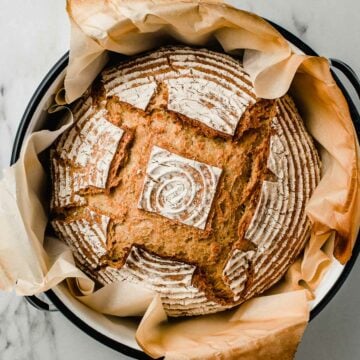
Einkorn Sourdough Bread
INGREDIENTS
INGREDIENTS TO MAKE 1 CUP (200 G) OF ACTIVE SOURDOUGH STARTER
- 1 ½ tablespoons (25 g) sourdough starter
- ¾ cup + 1 tablespoon (100 g) all-purpose einkorn flour
- 7 tablespoons (100 g) water
Dough Ingredients
- 1 cup (200 g) active sourdough starter
- 1 ¼ cup (300 g) water
- 4 ⅕ cups (540 g) all-purpose einkorn flour
- 2 teaspoons (10 g) sea salt
INSTRUCTIONS
Feed your sourdough starter
- 12 hours before you plan to mix the dough, add the ingredients to make 1 cup (200 g) of active sourdough starter to a clean jar: 25g sourdough starter, 100g einkorn all-purpose flour and 100g water. Stir until combined, loosely cover the jar and let the starter rise at room temperature. (The ingredients will create a total of 225 g active starter but, because some of it will stick to the sides of the jar during the transfer, we are making a little more than needed.) The sourdough starter is ready to use when it has doubled in size and there are plenty of bubbles on the surface and sides of the jar.
Make the dough
- Mix the dough ingredients. Add the 200g active sourdough starter, 540g all-purpose einkorn flour, 300g water and 10g salt to a large mixing bowl. Use a dough whisk or an off-set spatula to mix the ingredients together until there are no dry bits left in the bowl. Cover the bowl and let the dough rest for 1 hour.
- Fold the dough. Use a bowl scraper to turn the dough out onto a floured work surface. Flour the top of the dough and use your fingers to gently press it out into a rectangular shape.Starting with one side of the dough, lift it up and fold it toward the center of the dough. If the dough is sticking to the work surface, use the bench scraper to help it release. Repeat this on all four sides of the dough and place the dough back into the bowl. Cover the bowl and let the dough rest for 15 minutes. Repeat the folding process one more time.
- First rise. Place the dough back into the bowl and cover. Allow the dough to rise at room temperature for 3-4 hours or until it has risen by 20-30%.
- Shape the dough. Turn the dough out onto a floured surface. Pull the sides of the dough into the middle, working all the way around the outside and then flip the dough over. Use your hands to cup the dough around the bottom near the work surface and turn it so that the dough forms a taut ball.
- Second rise. Place the dough, seam-side up in to a floured banneton or one lined with a clean tea towel. Cover the dough and allow to rise at room temperature. Set a timer for 30 minutes.When the timer goes off, turn on the oven to preheat to 500°F (260 °C) with the dutch oven inside. Set a timer for 1 hour and allow the oven to preheat for the final hour of the second rise. (The dough will rise for a total of 1 hour and 30 minutes.)
- Score the dough. Remove the dutch oven and set on top of your stove. Turn the dough out onto a piece of parchment paper. Score the top of the dough with a razor or sharp knife no deeper than ¼". Use the parchment paper like a sling to transfer the dough to the dutch oven. Cover with the lid and place it back into the oven. Turn the oven down to 450°F (232 °C)
- Bake for 40 minutes with the lid on. Remove the lid and check to see if the crust is dark enough to your liking. If it is, remove it and let cool. If not, bake for an additional 5-10 minutes uncovered.
- Cool. Allow the bread to cool for 2 hours before slicing.
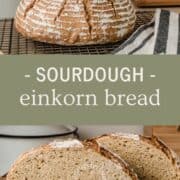

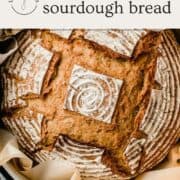

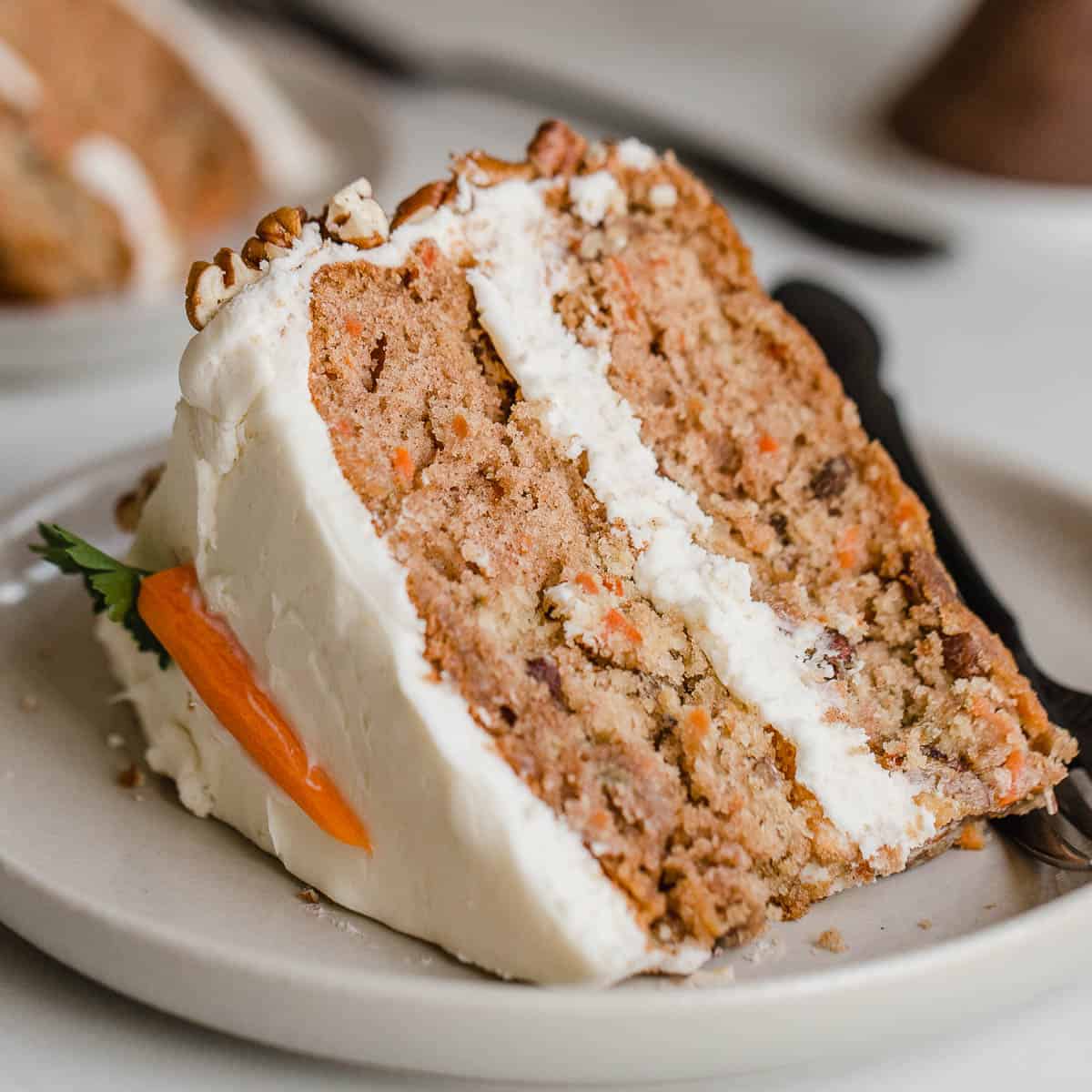
Maria says
Dear Amy,
Thank you very much for your recipe and your responses to the comments.
I began the process yesterday using your recipe as written and making some adjustments to the rising times in keeping with your responses, and today I baked it. I am very pleased with the results.
I had made some Einkorn bread before but it did not have as much oven spring as this one. I had used the same Jovial AP Einkorn flour.
I appreciate your generosity in sharing this recipe.
Blessings!
Olivia says
If I wanted to make the sourdough the next day, can I leave it to rise in the fridge overnight for the first rise and then 30 minutes at room temp for second rise the next day or let in rise 3-4 hours at room temp and then overnight in fridge until i bake it the next day? Or should it all be made in the same day? Thank you
Amy says
I would let it rise 3-4 hours at room temperature, shape and put in the fridge until the next day. Take it out to rise before baking if needed.
Heather says
Hi! What size Dutch oven is best?
Amy says
Anywhere from 4.5-6 quart size dutch oven is good for baking bread.
Gita Laoretti says
Can't wait to try this recepie. Just ordered the flour.
I was wondering, can I do this in a cold start oven?
Amy says
Yes you should be able to bake from a cold start.
Laura says
I have not made this yet, but have a question. Is the banneton necessary, or can something else be used? Most of my family is gluten intolerant, so I want to make this and make sure it will be a good fit for my family before I purchase extra kitchen equipment. Thank you so much!
Amy says
Hi Laura, you can use a regular bowl lined with a clean kitchen towel. I would make sure it is no bigger than 10" in diameter.
Laura says
Thank you so much! I can't wait to try this and if it works, I'll definitely be investing in the banneton!
carol says
I made this bread and it was so tasty. I am going to make it again. I did remove the dough from the bowl for the folds but I read on your reply to my previous comment that it can be done in the bowl. Is their a reason that you remove from the bowl? I used AP flour. Do you use AP flour for the folds or do you use einkorn flour for that as well. Also, during baking the the bread tore at the scoring. Any thoughts why? I really want to use this recipe on an ongoing basis as einkorn flour is a healthy flour. Thanks for your recipe and your help.
Amy says
I find it easier to remove this dough to do the folds. I do use einkorn for the entire process. As for the tear, einkorn definitely behaves differently than modern wheat because it has a lower gluten percentage which makes it less stretchy. That's why it "tore" while it baked. I hope that makes sense!
carol says
I have not yet made this bread but I am going to today. Can the folding be done in the bowl instead of taking it out and folding and putting back in the bowl? With other recipes I stretch and folds in the bowl.
Amy says
Yes it can!
Kellie says
I am milling my einkorn fresh, would recommend the same flour measurement? Or would it be different?
Amy says
It will be the same!
Justine says
I’ve had trouble with my Einkorn bread being very dense, and ending up making croutons and breadcrumbs. I splurged for a banneton and lame .This came out perfect and just like the video which was very helpful and really appreciated the time table. Really happy with the results.
Stacy Hughes says
Thanks for this delicious recipe! My family devours it when I make it and my 20 yo son now asks to make it with me when he is home! Question- do you buy your flour in bulk and if so, would you share your source? It’s pricey to purchase in little 32 0z bags from While Foods!
Amy says
Hi Stacy! I order in bulk from Azure Standard. 🙂